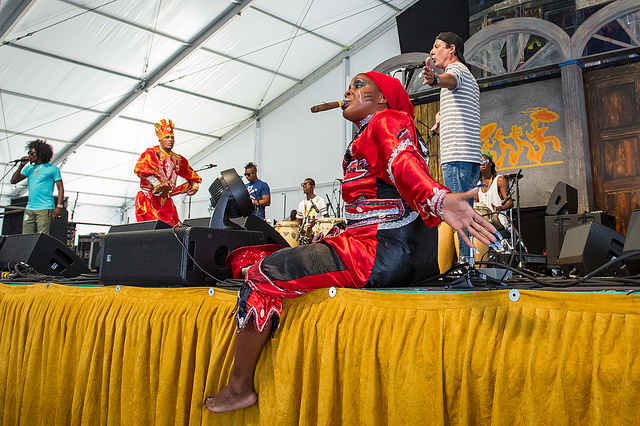The Music Festival culture created by George Wein at the Newport Jazz Fest and perfected here in New Orleans by Wein and the New Orleans Jazz and Heritage organization has become an institution of its own. For 48 years Jazz Fest here in New Orleans has presented the best of what the city’s unique culture has to offer. In recent years, as many of the icons of the city’s music have passed away, local headliners have been replaced by national acts that have expanded the festival’s commercial appeal but have not managed to rob the event of its core identity.
Alongside the decision to bring in non-New Orleans headliners was the brilliant idea to feature a guest country each year, bringing musicians with roots common to those of New Orleans into the mix. This has been a refreshing, educational and often musically stimulating addition to the Jazz Fest lineup. Up until now my favorite cultural exchange has been the year the Brazilian musicians came to town and played with everyone.
But this year’s guest country, Cuba, proved to be the most spectacular choice yet. We have been cut off from interacting with this nation’s music for more than half a century, but the lifting of the embargo allows us to see how closely Cuban music is aligned with the music of New Orleans. The common roots are intertwined in the African ancestry of the music, but there is more than just common ground here. There’s a sense of identity, like being reunited with a long lost family member. The deep links between Havana and New Orleans, the two major port cities in the region since the colonial era, have been reestablished.
It’s almost as is Jazz Fest was taken over, or somehow completed, by the Cuban correspondence. It seemed like everywhere I walked over the course of Jazz Fest I heard congeros beating a clave rhythm into the air. Often I couldn’t tell where it was coming from, because it was represented everywhere, from the Kids Tent to the Jazz and Heritage Stage, from Congo Square to the Fais Do-Do stage. And of course at the cultural pavilion, where a festival inside a festival rolled with its own rules.
Of course, conga drums figure prominently in New Orleans music as well, and even national acts like Stevie Wonder and Earth, Wind and Fire use congas as part of the rhythm section. So the sound was wonderfully ubiquitous, and also a kind of completion. Many of the Cuban musicians used nothing but the human voice and percussion instruments to create exciting montunos that built in intensity and seemed to overspill their borders at will. A five piece band at the cultural pavilion might suddenly at the end of the set explode into a 15-piece maelstrom of chanting voices, polyrhythms and dancers. More than one observer noted how close in spirit this music is to that of the Mardi Gras Indians, and on the last day, Big Chief Juan Pardo & Jockimo’s Groove featured two Cuban percussionists in the mix at the Heritage Stage. Once again, Jazz Fest was able to renew itself in a surprising way.





